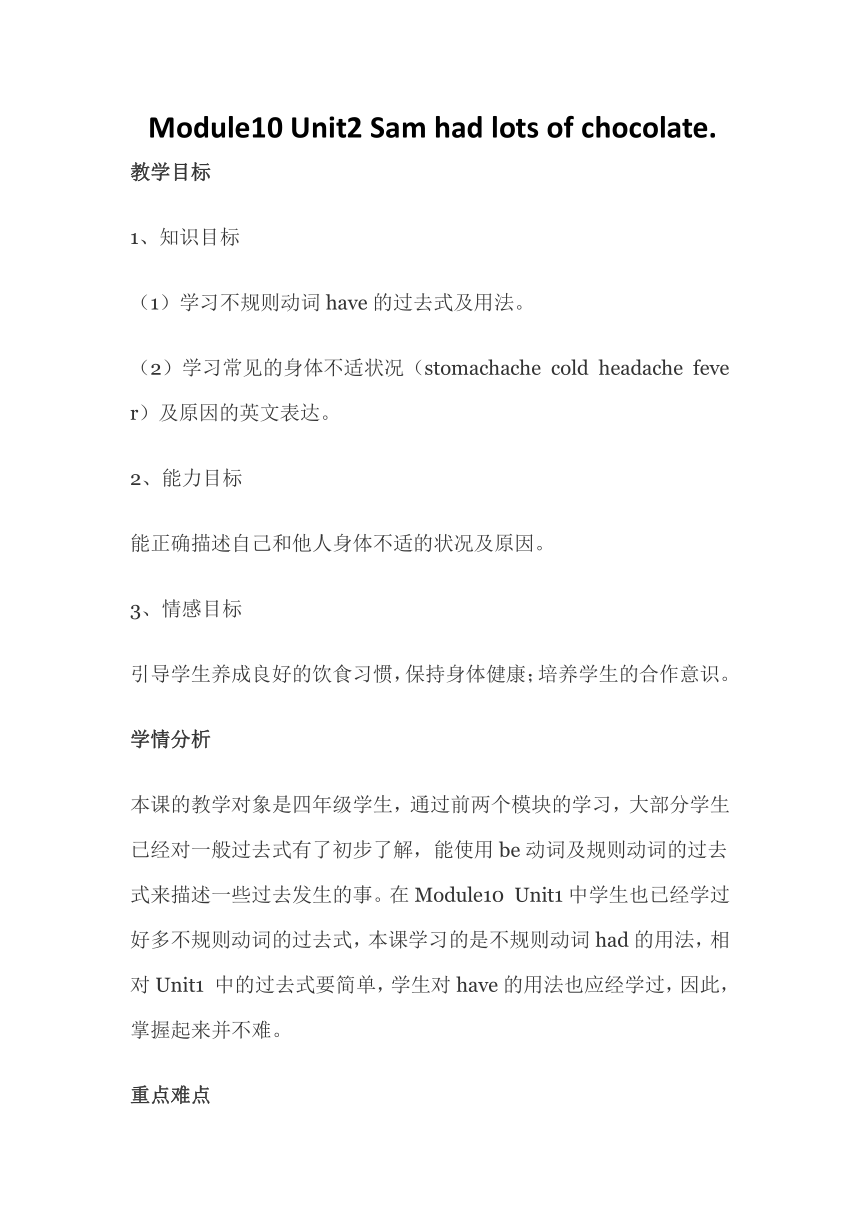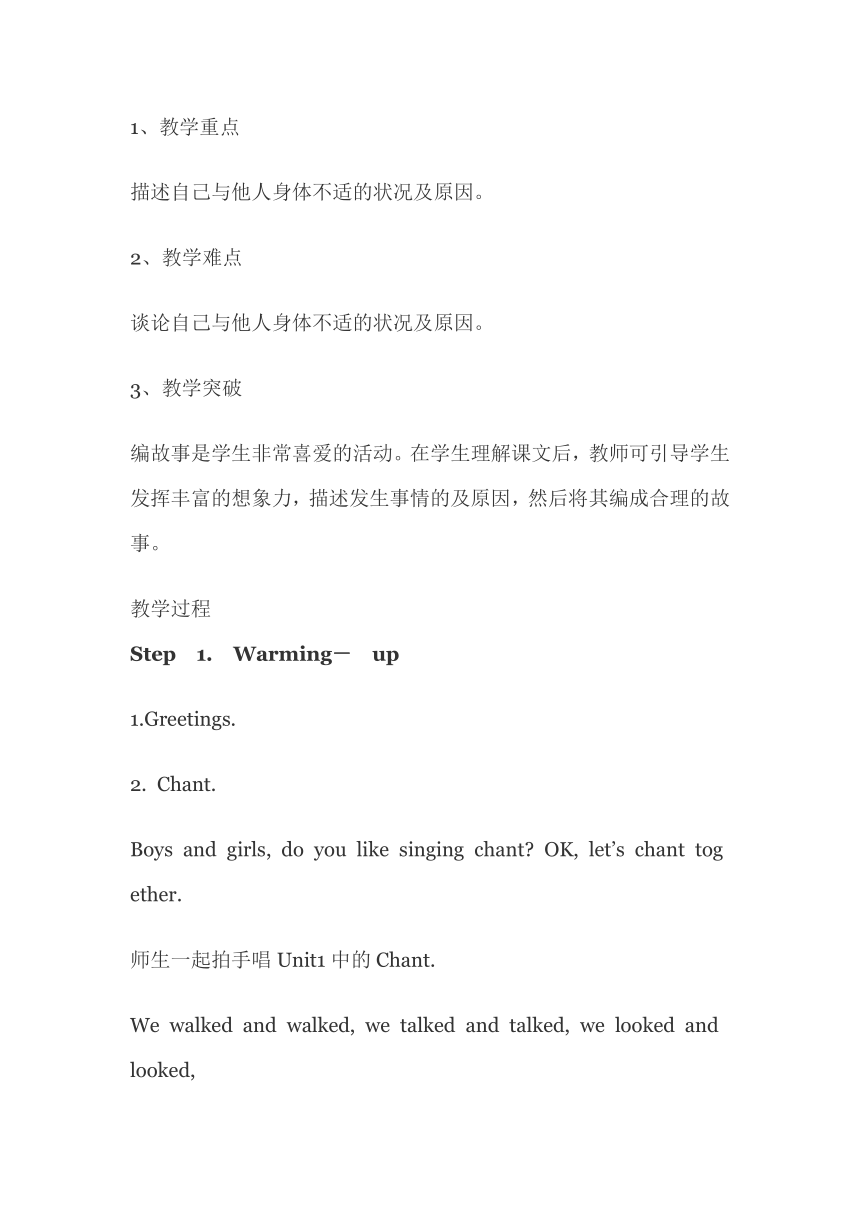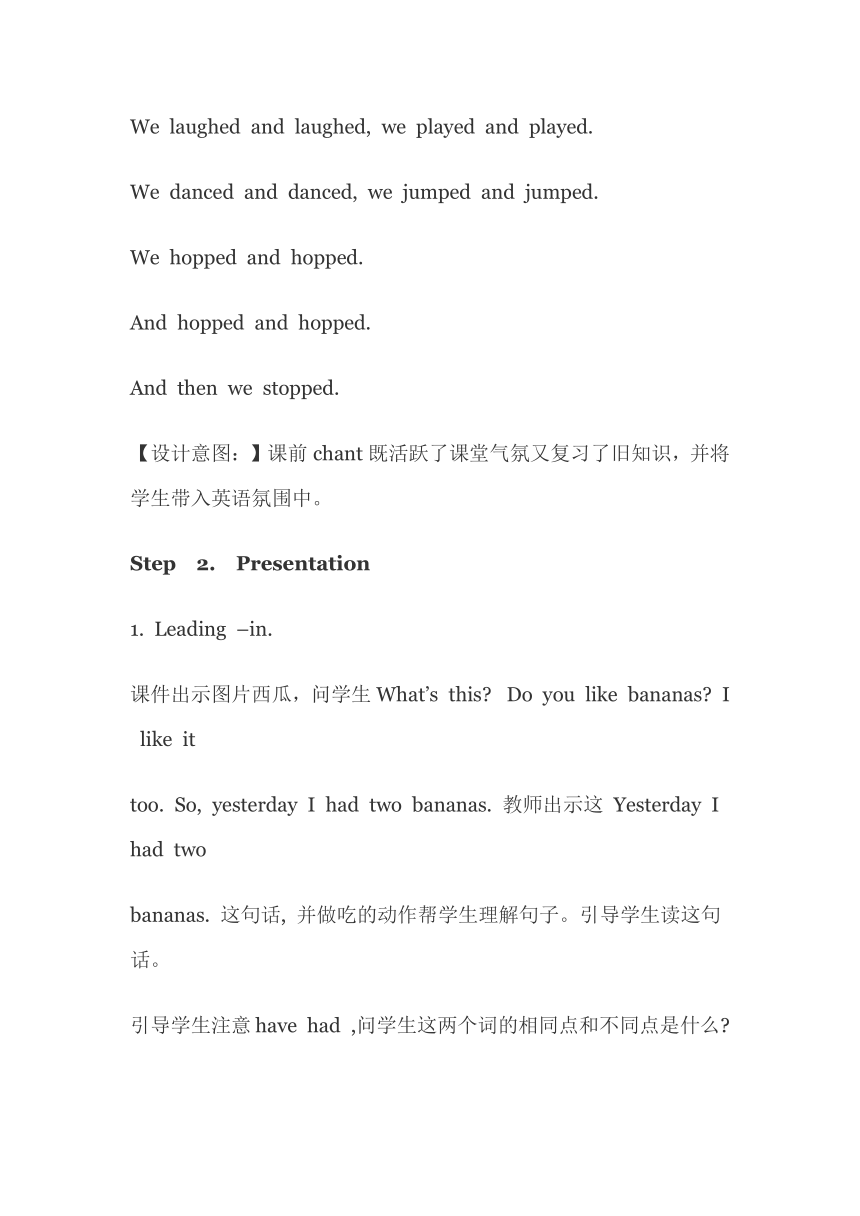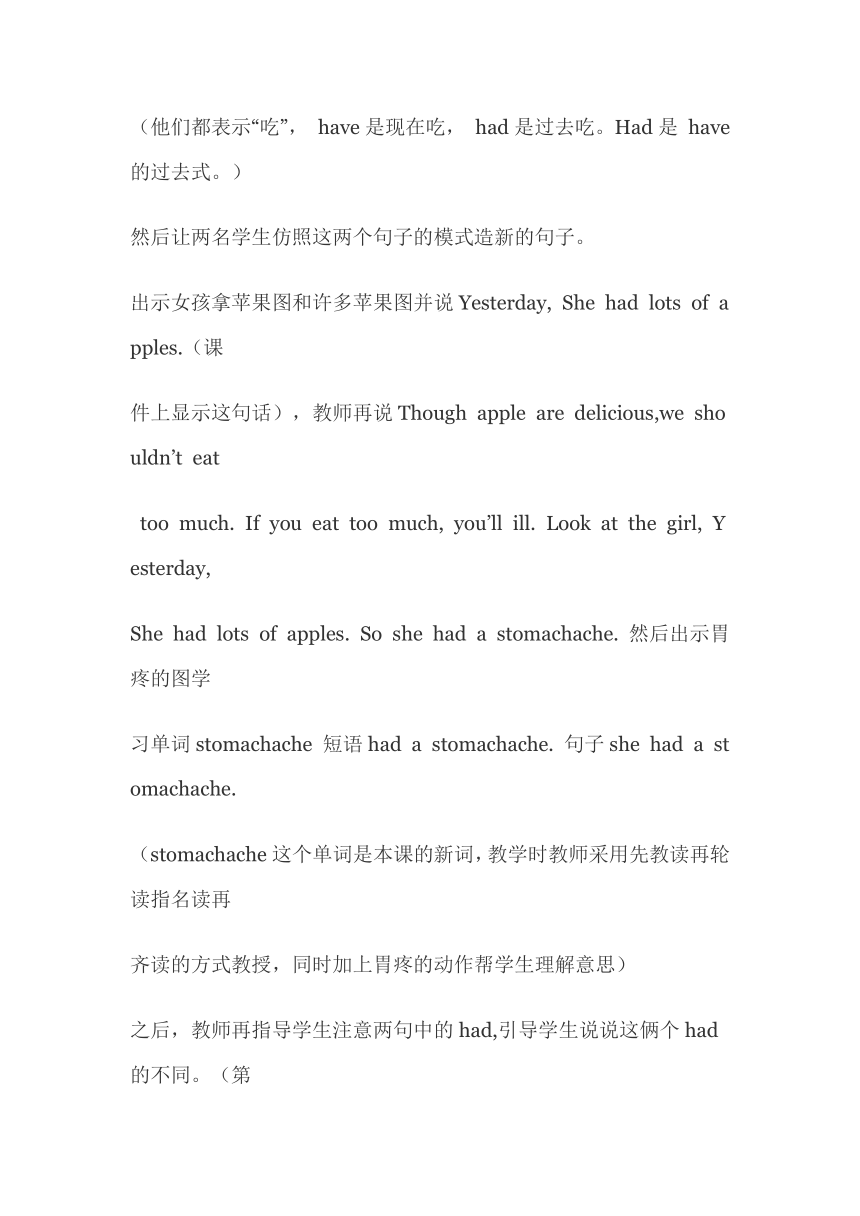Module 10 Unit 2 Sam had lots of chocolate. 教案
文档属性
| 名称 | Module 10 Unit 2 Sam had lots of chocolate. 教案 |  | |
| 格式 | doc | ||
| 文件大小 | 33.0KB | ||
| 资源类型 | 教案 | ||
| 版本资源 | 外研版(三年级起点) | ||
| 科目 | 英语 | ||
| 更新时间 | 2021-06-23 10:29:43 | ||
图片预览




文档简介
Module10 Unit2 Sam had lots of chocolate.
教学目标
1、知识目标
(1)学习不规则动词have的过去式及用法。
(2)学习常见的身体不适状况(stomachache cold headache fever)及原因的英文表达。
2、能力目标
能正确描述自己和他人身体不适的状况及原因。
3、情感目标
引导学生养成良好的饮食习惯,保持身体健康;培养学生的合作意识。
学情分析
本课的教学对象是四年级学生,通过前两个模块的学习,大部分学生已经对一般过去式有了初步了解,能使用be动词及规则动词的过去式来描述一些过去发生的事。在Module10 Unit1中学生也已经学过好多不规则动词的过去式,本课学习的是不规则动词had的用法,相对Unit1 中的过去式要简单,学生对have的用法也应经学过,因此,掌握起来并不难。
重点难点
1、教学重点
描述自己与他人身体不适的状况及原因。
2、教学难点
谈论自己与他人身体不适的状况及原因。
3、教学突破
编故事是学生非常喜爱的活动。在学生理解课文后,教师可引导学生发挥丰富的想象力,描述发生事情的及原因,然后将其编成合理的故事。
教学过程
Step 1. Warming- up
1.Greetings.
2. Chant.
Boys and girls, do you like singing chant? OK, let’s chant together.
师生一起拍手唱Unit1中的Chant.
We walked and walked, we talked and talked, we looked and looked,
We laughed and laughed, we played and played.
We danced and danced, we jumped and jumped.
We hopped and hopped.
And hopped and hopped.
And then we stopped.
【设计意图:】课前chant既活跃了课堂气氛又复习了旧知识,并将学生带入英语氛围中。
Step 2. Presentation
1. Leading –in.
课件出示图片西瓜,问学生What’s this?? Do you like bananas? I like it
too. So, yesterday I had two bananas. 教师出示这 Yesterday I had two
bananas. 这句话, 并做吃的动作帮学生理解句子。引导学生读这句话。
引导学生注意have had ,问学生这两个词的相同点和不同点是什么?
(他们都表示“吃”, have是现在吃, had是过去吃。Had是 have的过去式。)
然后让两名学生仿照这两个句子的模式造新的句子。
出示女孩拿苹果图和许多苹果图并说Yesterday, She had lots of apples.(课
件上显示这句话),教师再说Though apple are delicious,we shouldn’t eat
too much. If you eat too much, you’ll ill. Look at the girl, Yesterday,
She had lots of apples. So she had a stomachache. 然后出示胃疼的图学
习单词stomachache 短语had a stomachache. 句子she had a stomachache.
(stomachache这个单词是本课的新词,教学时教师采用先教读再轮读指名读再
齐读的方式教授,同时加上胃疼的动作帮学生理解意思)
之后,教师再指导学生注意两句中的had,引导学生说说这俩个had 的不同。(第
一had是吃的意思,第二个had 是患病的意思。)
【设计意图:】此环节使学生轻松理解have-had 意思和用法,并学会初步运用。
2. New words.
This class we’ll learn some other words about ill. Look at these pictures.
( 教师依次出示感冒,发烧,头疼的图学习单词cold fever headache及短语
had a cold/ fever/ headache, 学习这些单词的流程同stomachache。)
学完这四个新单词后,教师再次快速展示这四幅图,看谁能又快又准的说出单词。
之后教师和学生一起chant.
Today, today,?? I have apples.????????????????
Yesterday, yesterday,?Mum had bananas.
Cold cold,?Tiger had a cold.
Fever fever, Monkey had a fever.?
Headache, headache, Dog had a headache.
Stomachache, stomachache,
Little pig had a stomachache
【设计意图:】通过先教读再轮读指名读再齐读的教授方式教师能全面了解学生
的发音。加动作读单词能帮助理解句子的意思。学生在chant中又重新复习了
have-had和新学的单词。
3. New text.
1、一听课文。
Sam? Daming? Amy and Lingling are ill (生病)today. Listen and circle
the answers. What’s the matter with them today?(他们到底怎么了)
?幻灯片出示问题答案。Today he’s got a stomachache. Today he’s got a
stomachache. Today she’s got a headache. Today she’s got a fever.
2、再听课文
Listen and circle the answer,What happened to Sam? Daming? Amy and Lingling yesterday? (昨天他们怎么了?)
幻灯片出示问题答案。Sam had lots of chocolate biscuits yesterday.
Daming had two watermelons yesterday. Amy had a cold yesterday.
Lingling had a headache yesterday.
【设计意图:】带问题听课文能增强学生的学习兴趣。使听更有目的性。
3、Listen and say.
【设计意图:】? 跟读磁带能培养学生正确的发音和语感。
4、看图说句子
出示本课的课本图片,让学生说出学过的句子。
【设计意图:】? 检查背课文是学生很厌倦的事,以这种方式检查学生句子的掌握情况,学生很喜欢。
5、填空
1.Daming had two watermelons yesterday,(???? )today he’s got a
stomachache.
2.Amy had a cold yesterday,(?????? ) today she’s got a headache.
【设计意图:】 这个练习提醒学生注意关联词的使用。。
Step 3: Practice
用Yesterday I…, and today I…
Yesterday I…, so today I…编故事。
【设计意图:】编故事是学生非常喜爱的活动。在学生理解课文后,教师可引导学生发挥丰富的想象力,描述发生事情的及原因,然后将其编成合理的故事。
Step 4: Summary
让学生总结学到的知识。
【设计意图:】学生对这节课学到了什么做到心中有数。
教学目标
1、知识目标
(1)学习不规则动词have的过去式及用法。
(2)学习常见的身体不适状况(stomachache cold headache fever)及原因的英文表达。
2、能力目标
能正确描述自己和他人身体不适的状况及原因。
3、情感目标
引导学生养成良好的饮食习惯,保持身体健康;培养学生的合作意识。
学情分析
本课的教学对象是四年级学生,通过前两个模块的学习,大部分学生已经对一般过去式有了初步了解,能使用be动词及规则动词的过去式来描述一些过去发生的事。在Module10 Unit1中学生也已经学过好多不规则动词的过去式,本课学习的是不规则动词had的用法,相对Unit1 中的过去式要简单,学生对have的用法也应经学过,因此,掌握起来并不难。
重点难点
1、教学重点
描述自己与他人身体不适的状况及原因。
2、教学难点
谈论自己与他人身体不适的状况及原因。
3、教学突破
编故事是学生非常喜爱的活动。在学生理解课文后,教师可引导学生发挥丰富的想象力,描述发生事情的及原因,然后将其编成合理的故事。
教学过程
Step 1. Warming- up
1.Greetings.
2. Chant.
Boys and girls, do you like singing chant? OK, let’s chant together.
师生一起拍手唱Unit1中的Chant.
We walked and walked, we talked and talked, we looked and looked,
We laughed and laughed, we played and played.
We danced and danced, we jumped and jumped.
We hopped and hopped.
And hopped and hopped.
And then we stopped.
【设计意图:】课前chant既活跃了课堂气氛又复习了旧知识,并将学生带入英语氛围中。
Step 2. Presentation
1. Leading –in.
课件出示图片西瓜,问学生What’s this?? Do you like bananas? I like it
too. So, yesterday I had two bananas. 教师出示这 Yesterday I had two
bananas. 这句话, 并做吃的动作帮学生理解句子。引导学生读这句话。
引导学生注意have had ,问学生这两个词的相同点和不同点是什么?
(他们都表示“吃”, have是现在吃, had是过去吃。Had是 have的过去式。)
然后让两名学生仿照这两个句子的模式造新的句子。
出示女孩拿苹果图和许多苹果图并说Yesterday, She had lots of apples.(课
件上显示这句话),教师再说Though apple are delicious,we shouldn’t eat
too much. If you eat too much, you’ll ill. Look at the girl, Yesterday,
She had lots of apples. So she had a stomachache. 然后出示胃疼的图学
习单词stomachache 短语had a stomachache. 句子she had a stomachache.
(stomachache这个单词是本课的新词,教学时教师采用先教读再轮读指名读再
齐读的方式教授,同时加上胃疼的动作帮学生理解意思)
之后,教师再指导学生注意两句中的had,引导学生说说这俩个had 的不同。(第
一had是吃的意思,第二个had 是患病的意思。)
【设计意图:】此环节使学生轻松理解have-had 意思和用法,并学会初步运用。
2. New words.
This class we’ll learn some other words about ill. Look at these pictures.
( 教师依次出示感冒,发烧,头疼的图学习单词cold fever headache及短语
had a cold/ fever/ headache, 学习这些单词的流程同stomachache。)
学完这四个新单词后,教师再次快速展示这四幅图,看谁能又快又准的说出单词。
之后教师和学生一起chant.
Today, today,?? I have apples.????????????????
Yesterday, yesterday,?Mum had bananas.
Cold cold,?Tiger had a cold.
Fever fever, Monkey had a fever.?
Headache, headache, Dog had a headache.
Stomachache, stomachache,
Little pig had a stomachache
【设计意图:】通过先教读再轮读指名读再齐读的教授方式教师能全面了解学生
的发音。加动作读单词能帮助理解句子的意思。学生在chant中又重新复习了
have-had和新学的单词。
3. New text.
1、一听课文。
Sam? Daming? Amy and Lingling are ill (生病)today. Listen and circle
the answers. What’s the matter with them today?(他们到底怎么了)
?幻灯片出示问题答案。Today he’s got a stomachache. Today he’s got a
stomachache. Today she’s got a headache. Today she’s got a fever.
2、再听课文
Listen and circle the answer,What happened to Sam? Daming? Amy and Lingling yesterday? (昨天他们怎么了?)
幻灯片出示问题答案。Sam had lots of chocolate biscuits yesterday.
Daming had two watermelons yesterday. Amy had a cold yesterday.
Lingling had a headache yesterday.
【设计意图:】带问题听课文能增强学生的学习兴趣。使听更有目的性。
3、Listen and say.
【设计意图:】? 跟读磁带能培养学生正确的发音和语感。
4、看图说句子
出示本课的课本图片,让学生说出学过的句子。
【设计意图:】? 检查背课文是学生很厌倦的事,以这种方式检查学生句子的掌握情况,学生很喜欢。
5、填空
1.Daming had two watermelons yesterday,(???? )today he’s got a
stomachache.
2.Amy had a cold yesterday,(?????? ) today she’s got a headache.
【设计意图:】 这个练习提醒学生注意关联词的使用。。
Step 3: Practice
用Yesterday I…, and today I…
Yesterday I…, so today I…编故事。
【设计意图:】编故事是学生非常喜爱的活动。在学生理解课文后,教师可引导学生发挥丰富的想象力,描述发生事情的及原因,然后将其编成合理的故事。
Step 4: Summary
让学生总结学到的知识。
【设计意图:】学生对这节课学到了什么做到心中有数。
同课章节目录
- Module 1
- Unit 1 She's a nice teache
- Unit 2 He's cool.
- Module 2
- Unit 1 London is a big city.
- Unit 2 It's very old.
- Module 3
- Unit 1 Robots will do everything.
- Unit 2 On Monday I'll go swimming.
- Module 4
- Unit 1 Will you take your kite?
- Unit 2 Will it be hot in Haikou?
- Module 5
- Unit 1 I was two then.
- Unit 2 They were young.
- Module 6
- Unit 1 Were you at home yesterday?
- Unit 2 Was it a big city then ?
- Module 7
- Unit 1 I helped Mum.
- Unit 2 Grandma cooked fish.
- Module 8
- Unit 1 They sang beautifully.
- Unit 2 I took some pictures.
- Module 9
- Unit 1 Did he live in New York ?
- Unit 2 Did you have a nice holiday?
- Review Module
- Unit 1
- Unit 2
- Module 10
- Unit 1 Did you fall off your bike?
- Unit 2 Sam had lots of chocolate.
